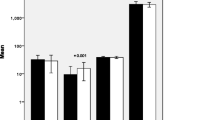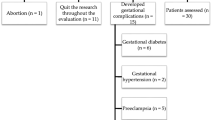Abstract
The relationship between late-onset gestational diabetes mellitus [GDM] and oxidative stress is not well known, and the importance of the oxidant/antioxidant equilibrium in the clinical evolution and its complications require elucidation. The aim of the study was to evaluate the relationships between maternal levels of markers of oxidative stress in women with late-onset GDM that, potentially, may have considerable clinical implications in the pathogenesis and/or the evolution of GDM. Pregnant women (n = 78; 53 with GDM, 25 controls), between the 24th and 29th week of gestation, were enrolled. Both groups were analysed for demographic data, perinatal and obstetrics outcomes together with the levels of the marker’s oxidative stress and antioxidant status. Control versus patient results in the univariate analysis were the following: pre-gestational body mass index [BMI] 23.31 ± 4.2 vs. 27.13 ± 4.6 kg/m2 (P = 0.001); weeks at delivery 39.2 ± 3.05 vs. 38.9 ± 1.8 (P = 0.09); Caesarean delivery 12.5 vs. 43% (P = 0.004); macrosomia 4 vs. 9.4% (P = 0.6); lipoperoxides [LPO] 2.06 ± 1.00 vs. 3.14 ± 1.55 μmol/mg (P = 0.001); catalase 3.23 ± 1.41 vs. 2.52 ± 1.3 nmol/min/ml (P = 0.03); superoxide dismutase [SOD] 0.11 ± 0.04 vs. 0.08 ± 0.01 U/ml (P = 0.0003); glutathione peroxidase [GPX] 0.03 ± 0.006 vs. 0.025 ± 0.006 nmol/min/ml (P = 0.01); glutathione reductase [GSH] 0.004 ± 0.002 vs. 0.004 ± 0.004 nmol/min/ml (P = 0.9)]; and glutathione transferase [GST] 0.0025 ± 0.0012 vs. 0.0027 ± 0.00017 nmol/min/ml (P = 0.7). Multivariate analysis showed catalase might have a protective effect against GDM development and LPO seems to be a risk factor for the disease. These data suggest an increase in oxidative stress and a decrease in antioxidative defence in women with late-onset GDM and, as such, may have considerable clinical implications in the pathogenesis and/or the course of the pregnancy in these patients.
Similar content being viewed by others
Abbreviations
- ANOVA:
-
Analysis of variance
- BMI:
-
Body mass index
- DMT1:
-
Diabetes mellitus type 1
- DMT2:
-
Diabetes mellitus type 2
- BPD :
-
Diastolic blood pressure
- GDM:
-
Gestational diabetes mellitus
- GPX:
-
Glutathione peroxidase
- GSH:
-
Glutathione reductase
- GST:
-
Glutathione transferase
- LGA:
-
Large-for-gestational age
- LPO:
-
Lipoperoxides
- MDA:
-
Malondialdehyde
- MetS:
-
Metabolic syndrome
- NF-kB:
-
Nuclear factor-kB
- OR:
-
Odds ratio
- ROS:
-
Reactive oxidative substances
- SD:
-
Standard deviation
- SE:
-
Standard error
- SOD:
-
Superoxide dismutase
- BPS :
-
Systolic blood pressure
- TBARS:
-
Thiobarbituric acid reactive substances
- TAC:
-
Total antioxidant capacity
- TG:
-
Triglycerides
References
Ben-Haroush A, Yogev Y, Hod M (2004) Epidemiology of gestational diabetes mellitus and its association with type 2 diabetes. Diabetic Med 21:103–113
Ostlund I, Hanson U, Björklund A et al (2003) Maternal and fetal outcomes if gestational impaired glucose tolerance is not treated. Diabetes Care 26:2107–2111
Albareda M, Caballero A, Badell G et al (2003) Diabetes and abnormal glucose tolerance in women with previous gestational diabetes. Diabetes Care 26:1199–1205
Catalano PM, Huston L, Amini SB, Kalhan SC (1999) Longitudinal changes in glucose metabolism during pregnancy in obese women with normal glucose tolerance and gestational diabetes. Am J Obstet Gynecol 180:903–916
Homko C, Sivan E, Chen X, Reece EA, Boden G (2001) Insulin secretion during and after pregnancy in patients with gestational diabetes mellitus. J Clin Endocrinol Metab 86:568–573
Xiang AH, Peters RK, Trigo E, Kjos SL, Lee WP, Buchanan TA (1999) Multiple metabolic defects during late pregnancy in women at high risk for type 2 diabetes mellitus. Diabetes 48:848–854
Metzger BE, The Organizing Committee (1991) Summary and recommendations of the 3rd international workshop-conference on gestational diabetes mellitus. Diabetes Care 40(Supp 2):197–201
Festa A, D’Agostino R Jr, Howard G, Mykkanen L, Tracy RP, Haffner SM (2000) Chronic subclinical inflammation as part of the insulin resistance syndrome: the insulin resistance atherosclerosis study (IRAS). Circulation 102:42–47
Bo S, Menato G, Gallo ML, Bardelli C et al (2004) Mild gestational hyperglycemia, the metabolic syndrome and adverse neonatal outcomes. Acta Obstet Gynecol Scand 83:335–340
Bartha JL, González-Bugatto F, Fernández-Macías R, González-González NL, Comino-Delgado R, Hervías-Vivancos B (2008) Metabolic syndrome in normal and complicated pregnancies. Eur J Obstet Gynecol Reprod Biol 137:178–184
Brownlee M (2001) Biochemistry and molecular cell biology of diabetic complications. Nature 414:813–820
Maddux BA, See W, Lawrence JC, Goldfine AL, Goldfine ID, Evans JL (2001) Protection against oxidative stress-induced insulin resistance in rat L6 muscle cells by mircomolar concentrations of alpha-lipoic acid. Diabetes 50:404–410
Chen K, Thomas SR, Keaney JF (2003) Beyond LDL oxidation: ROS in vascular signal transduction. Free Radic Biol Med 35:117–132
Ceriello A, Motz E (2004) Is oxidative stress the pathogenic mechanism underlying insulin resistance, diabetes, and cardiovascular disease? The common soil hypothesis revisited. Arterioscler Thromb Vasc Biol 24:816–823
Dröge W (2002) Free radicals in the physiological control of cell function. Physiol Rev 82:47–95
Haddad JJ (2002) Oxygen homeostasis, thiol equilibrium and redox regulation of signalling transcription factors in the alveolar epithelium. Cell Signal 14:799–810
Barnes PJ, Karin M (1997) Nuclear factor-kB: a pivotal transcription factor in chronic inflammatory diseases. N Engl J Med 336:1066–1071
Du XL, Edelstein D, Dimmeler S, Ju Q, Sui C, Brownlee M (2001) Hyperglycemia inhibits endothelial nitric oxide synthase activity by posttranslational modification at the Akt site. J Clin Invest 108:1341–1348
Santilli F, Cipollone F, Mezzetti A, Chiarelli F (2004) The role of nitric oxide in the development of diabetic angiopathy. Horm Metab Res 36:319–335
Basta G, Schmidt AM, DeCaterina R (2004) Advanced glycation end products and vascular inflammation: implications for accelerated atherosclerosis in diabetes. Cardiovasc Res 63:582–592
Esposito K, Nappo F, Marfella R et al (2002) Inflammatory cytokine concentrations are acutely increased by hyperglycemia in humans: role of oxidative stress. Circulation 106:2067–2072
Marfella R, Esposito K, Giunta R et al (2000) Circulating adhesion molecules in humans: role of hyperglycemia and hyperinsulinemia. Circulation 101:2247–2251
Ceriello A, Quagliaro L, Piconi L et al (2004) Effect of postprandial hypertriglyceridemia and hyperglycemia on circulating adhesion molecules and oxidative stress generation and the possible role of simvastatin treatment. Diabetes 53:701–710
Januszewski AS, Alderson NL, Metz TO, Thorpe SR, Baynes JW (2003) Role of lipids in chemical modification of proteins and development of complications in diabetes. Biochem Soc Trans 31:1413–1416
Jenkins AJ, Best JD, Klein RL, Lyons TJ (2004) Lipoproteins, glycoxidation and diabetic angiopathy. Diabetes Metab Res Rev 20:349–368
Baynes JW, Thrope SR (1999) Role of oxidative stress in diabetic complications. A new perspective on an old paradigm. Diabetes 48:1–9
Viana M, Herrera E, Bonet B (1996) Teratogenic effects of diabetes mellitus in the rat. Prevention by vitamin E. Diabetologia 39:1041–1046
Peuchant E, Brun JL, Rigalleau V et al (2004) Oxidative and antioxidative status in pregnant women with either gestational or type 1 diabetes. Clin Biochem 37:293–298
Chaudhari L, Tandon OP, Vaney N, Agarwal N (2003) Lipid peroxidation and antioxidant enzymes in gestational diabetics. Indian J Physiol Pharmacol 47:441–446
Rajdl D, Racek J, Steinerova A, Novotny Z, Stozicky F, Trefil L (2005) Markers of oxidative stress in diabetic mothers and their infants during delivery. Physiol Res 54:429–436
Orhan H, Önderoglu L, Yücel A, Sahin G (2003) Circulating biomarkers of oxidative stress in complicated pregnancies. Arch Gynecol Obstet 267:189–195
Toescu V, Nuttall SL, Martin U (2004) Changes in plasma lipids and markers of oxidative stress in normal pregnancy and pregnancies complicated by diabetes. Clin Sci 106:93–98
Karacay Ö, Sepici-Dincel A, Karcaaltincaba D et al (2010) A quantitative evaluation of total antioxidant status and oxidative stress markers in preeclampsia and gestational diabetic patients in 24–36 weeks of gestation. Diabetes Res Clin Pract 89:231–238
National Diabetes Data Group (1979) Classification and diagnosis of diabetes mellitus and other categories of glucose intolerance. Diabetes 28:1039–1057
Solomon CG, Willett WC, Carey VJ et al (1997) A prospective study of pregravid determinants of gestational diabetes mellitus. JAMA 278:1078–1083
Montelongo A, Lasuncion MA, Pallardo LF, Herrera E (1992) Longitudinal study of plasma lipoprotein and hormones during pregnancy in normal and diabetic women. Diabetes 41:1651–1659
Koukko E, Watts GF, Lowy C (1996) Serum lipid, lipoprotein and apolipoprotein changes in gestational diabetes mellitus: a cross-sectional and prospective study. J Clin Pathol 49:634–637
American Diabetes Association (1996) Gestational diabetes mellitus. Diabetes Care 27:88–90
Herranz L, Villaroel A, Riesco G et al (2003) Elective delivery in women with gestational diabetes mellitus. Diabetología 46:A248–A249
Acknowledgments
This study was financed, in part, by grants from the Andalusia Department of Health (CTS-368).
Conflict of interest
The authors declare that there is no conflict of interest that would prejudice the impartiality of this scientific work. Editorial assistance was by Dr Peter R Turner.
Author information
Authors and Affiliations
Corresponding author
Rights and permissions
About this article
Cite this article
López-Tinoco, C., Roca, M., García-Valero, A. et al. Oxidative stress and antioxidant status in patients with late-onset gestational diabetes mellitus. Acta Diabetol 50, 201–208 (2013). https://doi.org/10.1007/s00592-011-0264-2
Received:
Accepted:
Published:
Issue Date:
DOI: https://doi.org/10.1007/s00592-011-0264-2




